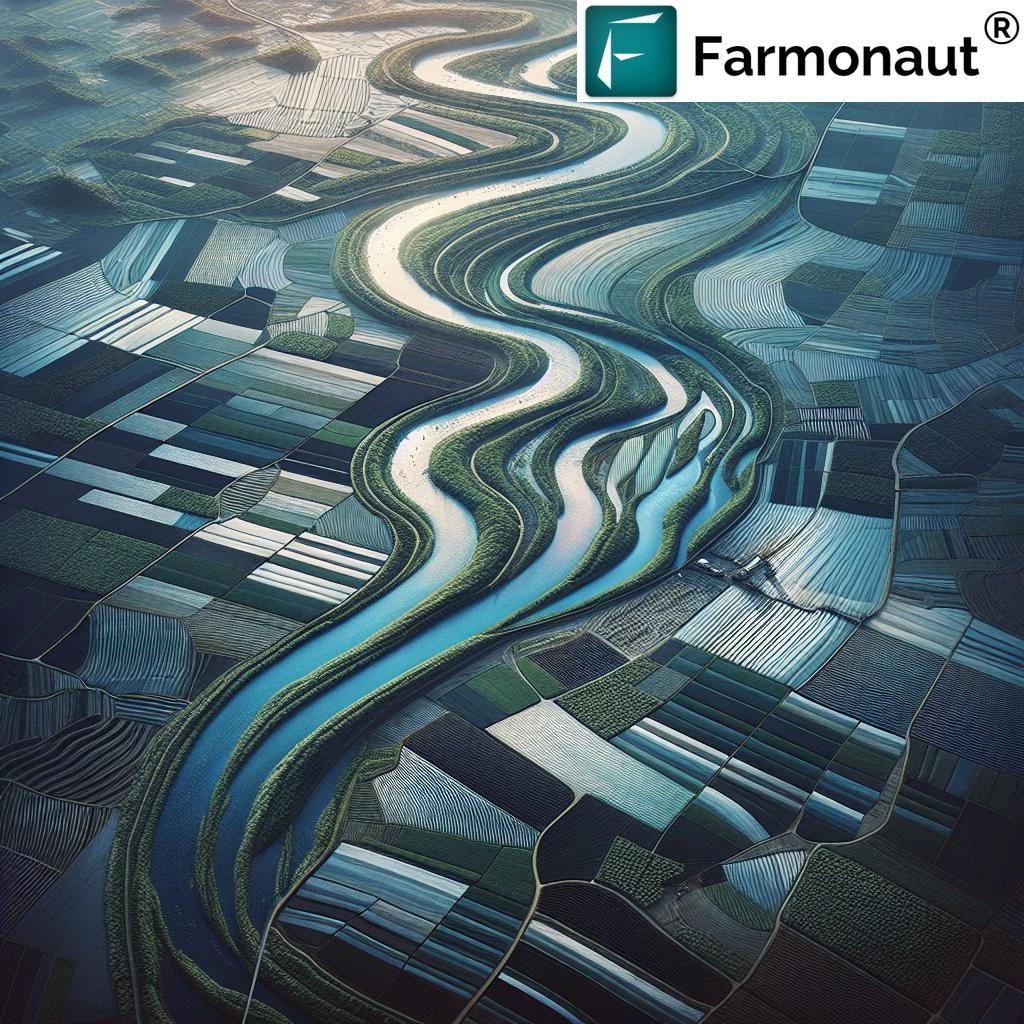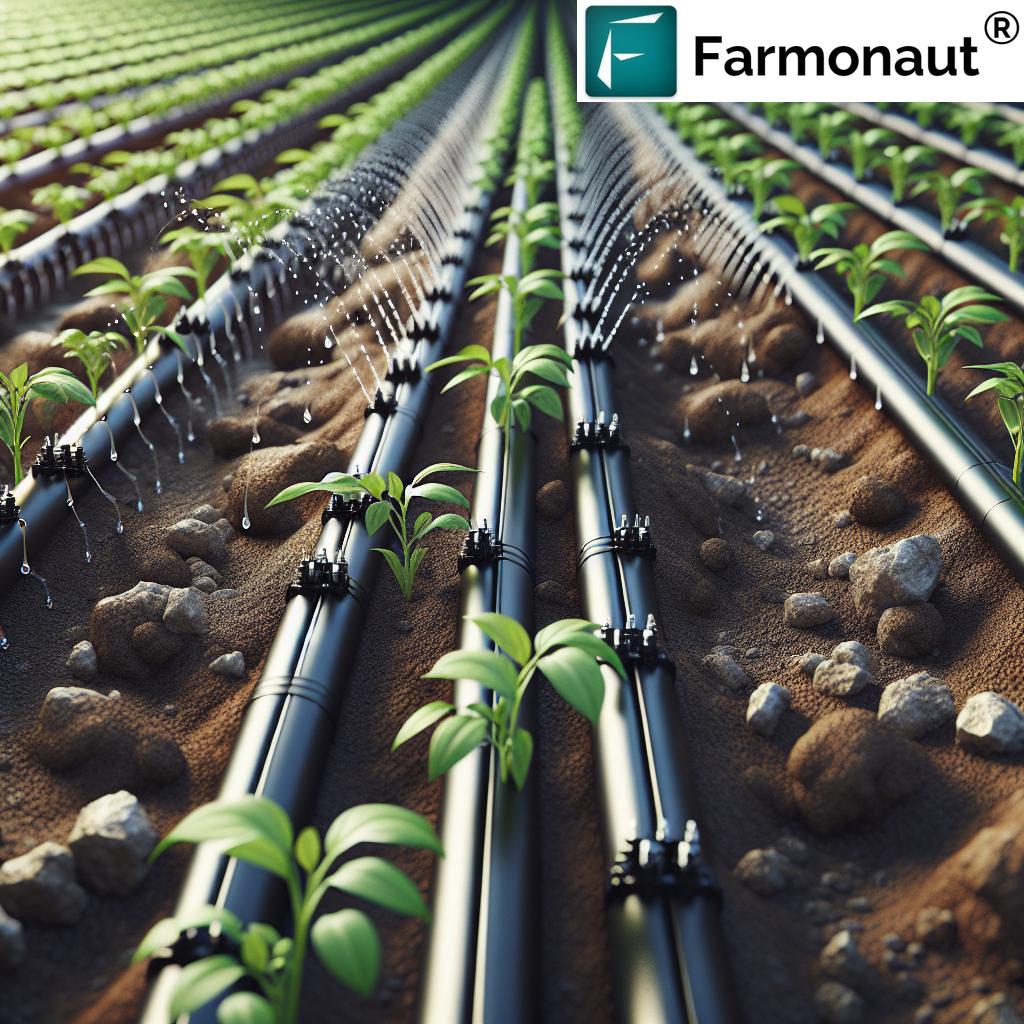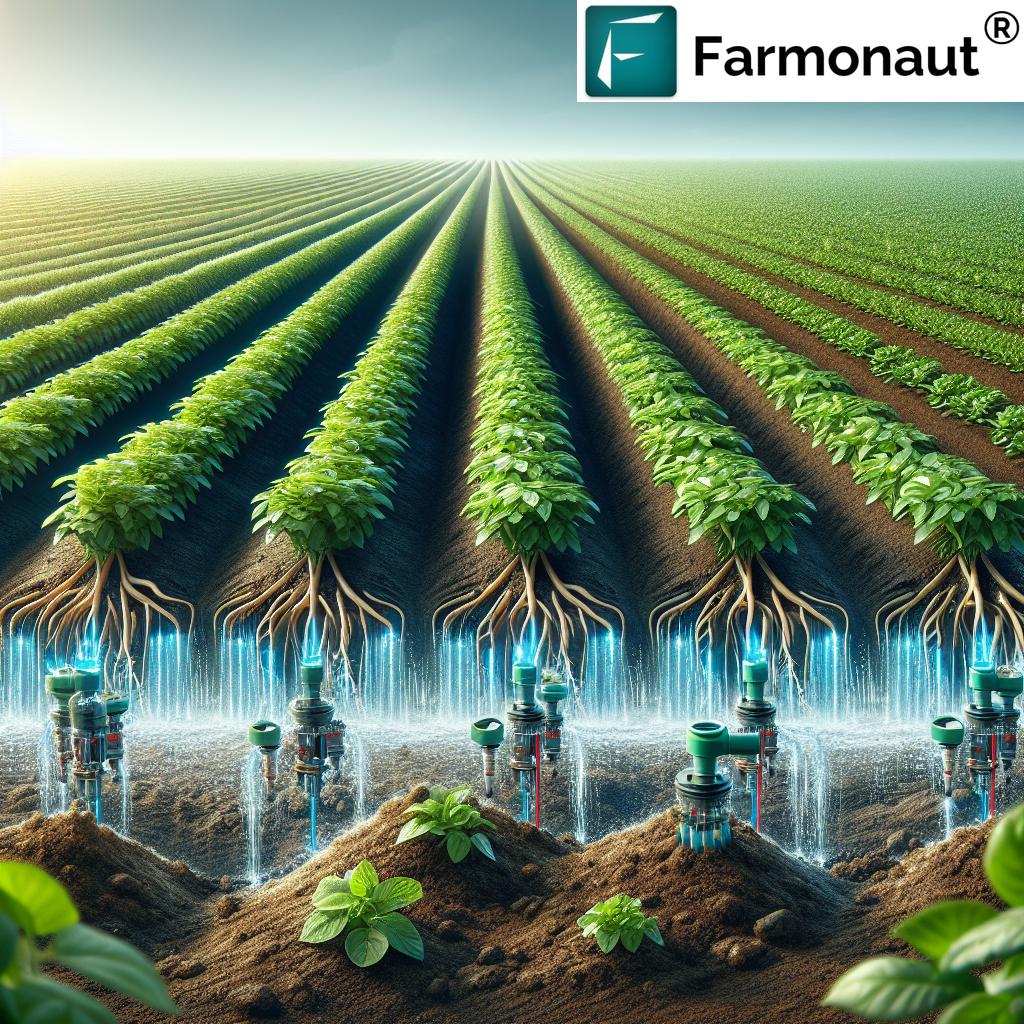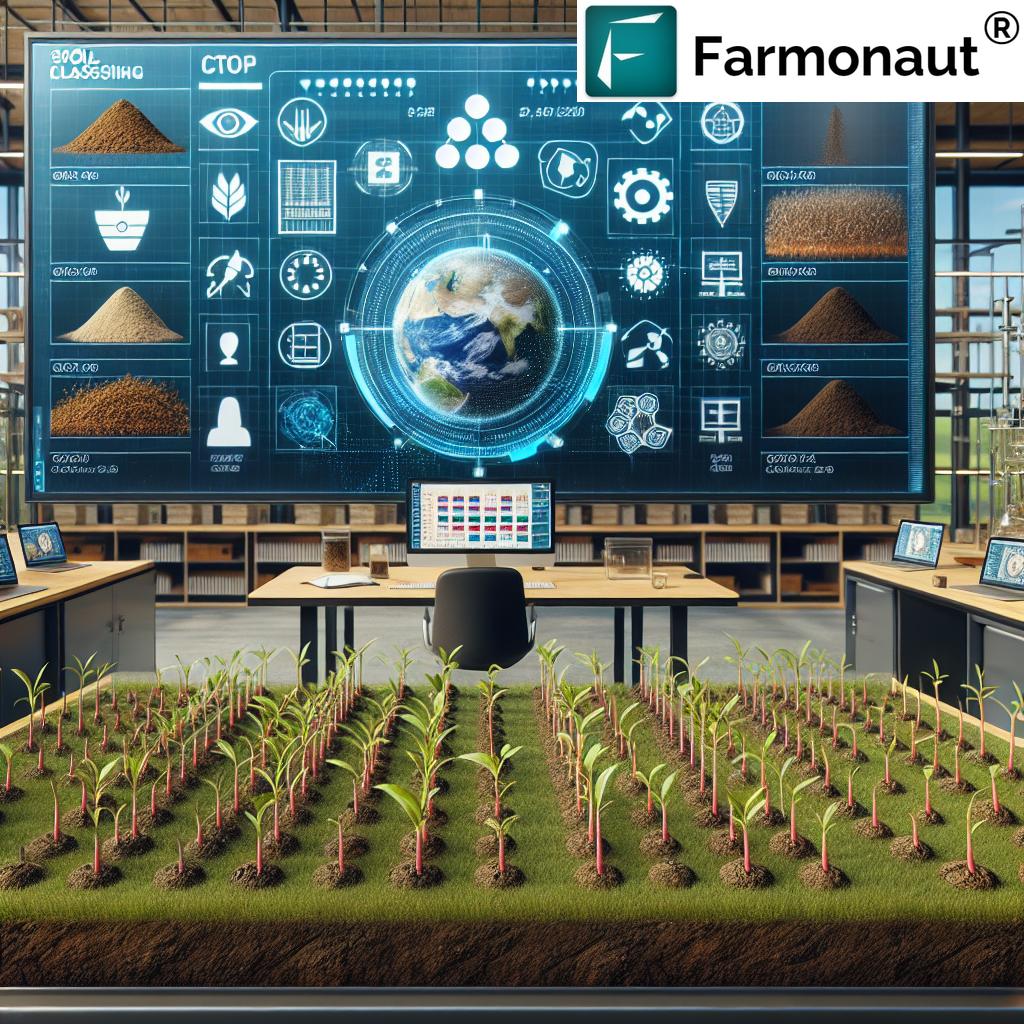Water Transfer from Rivers to Farms: 5 Game-Changers!
“Drip irrigation can reduce water usage by up to 60% compared to traditional flood irrigation methods.”
Table of Contents
- Introduction
- The Importance of Water Transfer in Agriculture
- 5 Game-Changing Water Transfer Methods
- Comparative Analysis of Water Transfer Methods
- Environmental and Economic Considerations
- Sustainable Water Management in Agriculture: Best Practices
- Efficient Agricultural Irrigation Technologies: Innovations for the Future
- How Farmonaut Empowers Sustainable Irrigation Solutions
- Frequently Asked Questions
- Conclusion
Introduction: Water Transfer in Agriculture—A Foundation for Food Security
Water transfer from rivers to farms forms the backbone of modern agriculture worldwide. In numerous regions where natural rainfall is insufficient, efficient and sustainable irrigation methods for farming ensure that essential water reaches our crops, directly impacting food production, livelihoods, and ecosystem balance. With advancing technology and increasing demand, it’s critical that we understand the methods, environmental impacts, and future-oriented techniques shaping water transfer in agriculture.
This comprehensive guide explores the five game-changing water transfer methods, dives into their environmental and economic implications, showcases best soil management for water conservation practices, and reveals how technologies like those from Farmonaut are reshaping agricultural water management.
Why Water Transfer from Rivers to Farms Matters
Water transfer in agriculture ensures we can achieve sustainable crop cultivation even in arid and semi-arid regions. This practice, known as river water for crop irrigation, supports millions of farmers, stabilizes food systems, and underpins rural economies. However, how we divert and manage this vital resource directly affects environmental sustainability, riverine ecosystems, and the resilience of our agricultural lands to climate challenges.
- Bridges the gap where rainfall is insufficient
- Powers irrigation systems that boost farm yields
- Enables diverse cropping patterns through reliable water supply
- Influences soil fertility, weed control, and erosion
- Requires effective sustainable water management in agriculture to protect rivers
“Efficient water transfer systems can increase crop yields by 20-30% while preserving river ecosystems.”
5 Game-Changers: How We Transfer Water from Rivers to Farms
Let’s dive into the fundamental and innovative irrigation methods for farming that are transforming our ability to deliver river water for crop irrigation. Each system brings unique strengths, suited to different regions, crop types, and farm sizes.
1. Surface Irrigation Techniques
Surface irrigation is the most traditional method for direct application of water. Here, water from canals or rivers flows over the land by gravity. Common surface irrigation techniques include:
- Furrow irrigation: Water moves along shallow channels dug between crop rows, ensuring even wetting of the soil.
- Basin irrigation: Small areas are surrounded by levees and filled with water, ideal for crops like rice.
- Flood irrigation: Large areas are inundated to saturate the field quickly—best when managed to minimize erosion and runoff.
While cost-effective, these methods can lead to inefficiencies if poorly managed—think water wastage, evaporation, and soil erosion. Advancements like lined canals and precise leveling are helping maximize system efficiency.
2. Drip Irrigation Systems: Precision at the Roots
A star among efficient agricultural irrigation technologies, drip irrigation delivers water directly to the plant roots using a pressurized network of pipes, tubes, and precise emitters. This technique reduces evaporation, minimizes weed growth, and conserves water dramatically.
- Benefits: Lowers water use, ensures optimal moisture, increases yields, enables automated control.
- Considerations: Requires initial investment, diligent maintenance to prevent clogging, and is best suited for high-value crops.
3. Center-Pivot Irrigation Systems: Technology for Large-Scale Farms
Center-pivot irrigation uses rotating sprinkler arms attached to wheeled towers, which sweep in a circular pattern—a familiar sight across vast farming lands in the US, Egypt, and Australia. This system achieves uniform distribution of water and can be programmed for precise soil moisture requirements.
- Pros: High efficiency for large fields, less labor, compatible with sensors for automated water management.
- Cons: Needs flat terrain, high energy consumption, requires capital investment.
4. Interbasin Transfer: Expanding Water Access
Interbasin transfer involves diverting water from one river basin to another, often via canals or pipelines, to alleviate drought or boost irrigation in water-scarce regions.
- Enables agriculture where local water sources are unreliable.
- Often involves complex engineering and environmental impact analysis.
- Requires robust policies to balance downstream river flow and ecosystem integrity.
5. Siphon Tubes: Simple Yet Effective
Using the siphon principle, simple tubes transfer water from a canal or channel over a barrier and into the field. Siphon tubes are widely used for small to medium plots, require minimal infrastructure, and can be moved as needed.
- Pros: Low-cost, portable, minimal energy requirements
- Cons: Labor-intensive, vulnerable to loss of siphon effect if not attended
Comparative Analysis of Water Transfer Methods
| Method Name | Description | Estimated Water Savings (%) | Cost Level (Range) | Environmental Impact | Suitability |
|---|---|---|---|---|---|
| Drip Irrigation | Delivers water directly to plant roots via tubing and emitters | Up to 60% | Moderate to High | Minimizes runoff and soil erosion, conserves water | Small to medium high-value crops; orchards, vegetables |
| Canal Lining (Surface Irrigation Upgrade) | Lining earthen canals with impermeable materials to reduce seepage | 20-40% | Moderate | Reduces water loss and protects soil | Large fields, traditional irrigation regions |
| Pipelines (Interbasin Transfer) | Enclosed pipes transfer water across long distances or basins | 30-50% | High | Reduces evaporation, requires careful environmental assessment | Large-scale, inter-regional irrigation projects |
| Rainwater Harvesting | Capturing and storing rainwater for crop irrigation | 25-40% | Low to Moderate | Enhances local water security and reduces runoff | All farm sizes, especially rain-fed farms |
| Controlled Flooding (Surface Techniques) | Planned, limited flooding during critical crop stages | 10-20% | Low | Can cause waterlogging if not managed | Paddy fields, basins, flat terrain |
Environmental and Economic Considerations in Water Transfer
While water transfer in agriculture fuels food security, our methods can inadvertently stress freshwater ecosystems, diminish river flows, and trigger soil salinization. Responsible management and innovation are essential to ensure long-term agricultural productivity and resilient water supplies.
Environmental Impacts of Irrigation on Rivers and Lands
-
Reduced River Flow:
- Excessive water withdrawal, especially during dry seasons, leads to depleted river flows—affecting fish, wetlands, and communities.
- Notably, major rivers like the Ganges have experienced flow reductions from extensive irrigation infrastructure (read more).
-
Soil Salinization:
- When irrigation is excessive or drainage is poor, salts can accumulate, harming soil fertility and structure—especially in arid regions where evaporation is high.
-
Waterlogging and Erosion:
- Surface irrigation, if not managed, can lead to waterlogging of roots or soil erosion from runoff.
Economic Impacts and Investment Needs
-
High Infrastructure Costs:
- Constructing canals, pipelines, and advanced irrigation systems requires significant investment.
-
Maintenance and Operational Expenses:
- Systems, especially drip and center-pivot irrigation, require steady maintenance and skilled management for optimal performance.
-
Long-Term Sustainability:
- Over-reliance on irrigation without attention to efficiency can threaten both ecosystems and farm profitability.
➡ Efficient Resource Management: Advanced farm resource tracking solutions such as Farmonaut’s Fleet Management help optimize the use of machinery, save operational costs, and reduce environmental footprints in irrigation infrastructure projects.
➡ Traceability: For supply chain transparency and to verify sustainable water management standards, Farmonaut’s Traceability Platform ensures every agricultural product’s journey—from river-irrigated farm to market—is recorded with blockchain trust.
➡ Environmental Monitoring: Calculate the carbon consequences of massive irrigation systems and move towards climate-friendly farming with Farmonaut Carbon Footprinting.
Sustainable Water Management in Agriculture: Best Practices for a Greener Future
Our global challenge: feeding more people using less water while protecting vital rivers and ecosystems. Here are the core sustainable practices and innovations revolutionizing water transfer for agriculture:
-
Water-Efficient Crops:
- Selecting drought-tolerant, high-yield crops for arid regions reduces irrigation demand.
-
Precision Irrigation Scheduling:
- Applying water according to measured soil moisture and crop needs (enabled by sensors or satellite data).
-
Improved Soil Management for Water Conservation:
- Enhancing soil organic matter, using mulches, and practicing crop rotation boosts soil water retention and reduces runoff.
-
Integrating Technology for Efficient Agricultural Irrigation:
- Leveraging satellite monitoring and AI-driven apps (like those from Farmonaut) for smart irrigation decisions.
-
Policies and Water Rights:
- Adopting government policies that incentivize efficient irrigation and balance farm needs with environmental flows.
➡ Crop Plantation & Forest Advisory: Receive personalized, AI-powered recommendations for your specific crop, soil, and climate with Farmonaut’s Crop Advisory Tools. It helps optimize called-out practices like crop rotation, irrigation scheduling, and species choice for sustainable growth.
Efficient Agricultural Irrigation Technologies: Next-Generation Solutions
Advancements in agricultural water management continue to drive leaps in both efficiency and sustainability. Let’s explore how innovative technologies are optimizing each phase of irrigation—planning, application, and monitoring:
- Satellite-Based Soil and Crop Health Insights: Satellite imagery platforms monitor soil moisture, crop growth stages, and impending water stress. This real-time data supports precise irrigation and minimizes over-watering. Explore Farmonaut’s Satellite Services for your farm or agribusiness.
- AI-Driven Advisory Systems: AI models integrate weather forecasts, historical field data, and real-time sensor input for predictive irrigation planning (Farmonaut Jeevn AI).
- Automated Drip and Sprinkler Systems: Sensors and automation allow for perfect on/off control, reducing labor and avoiding over-irrigation.
- Blockchain-Based Water Tracking: Modern traceability platforms help govern sustainable water rights and prove environmental compliance.
- Resource & Fleet Optimization APIs: Managing logistics and on-field machinery in distributed irrigation networks is easy with developer-friendly APIs—learn more at Farmonaut API and API Developer Docs.
➡ Crop Loan & Insurance: Get faster, fraud-resistant access to agricultural finance with Farmonaut’s Crop Loan Verification. Satellite data provides objective proof of irrigation practices and crop health for banks and insurers.
Ready to Transform Your Farm’s Water Management?
With Farmonaut, access affordable subscriptions for satellite-powered farm monitoring, irrigation management, and sustainability tracking—no expensive hardware required!
How Farmonaut Empowers Sustainable Water Transfer in Agriculture
Modern agricultural water transfer requires actionable, real-time insights to optimize irrigation while safeguarding ecosystems. Farmonaut stands at the forefront of this transformation, offering:
-
Satellite Crop Health Monitoring:
- Maps and analyzes vegetation vigor, NDVI, and soil moisture—perfect for scheduling irrigation precisely and detecting water stress early.
-
Jeevn AI Advisory:
- Delivers personalized, data-driven irrigation guidance based on networked sensors, satellite images, and weather models.
-
Blockchain-Based Traceability:
- Ensures transparency and ethical compliance across complex river-to-farm supply chains.
-
Resource and Fleet Management:
- Streamlines logistics, especially valuable in large canal, pipeline, or center-pivot-equipped farms.
-
Mobile and Web Accessibility:
- No matter your farm size, access Farmonaut Apps for affordable, scalable, and intuitive solutions for water and soil management.
Frequently Asked Questions (FAQ)
What are the main methods for water transfer in agriculture?
The five main methods are surface irrigation techniques (furrow, flood, and basin), drip irrigation systems, center-pivot irrigation systems, interbasin water transfer, and siphon tubes. Each method offers unique benefits and is suited to different crops, soil conditions, and geographic regions.
How does sustainable water management benefit farms and ecosystems?
Sustainable practices maximize crop yields while reducing environmental impacts such as excessive river withdrawal or soil salinization. Advanced technologies enable data-driven irrigation, minimize water wastage, and protect river ecosystems.
What are the economic considerations when investing in irrigation systems?
Investment includes the cost of infrastructure, ongoing maintenance, and operation. Choosing the right method for your soil, crop, and region can save water, improve yields, and ensure return on investment over the long term.
How can technology support efficient irrigation and water transfer?
Technologies like satellite crop monitoring, AI-driven advisory platforms, and resource management tools optimize irrigation scheduling, reduce losses, and provide transparency from river to market. Explore solutions with Farmonaut.
Are there solutions for large-scale farm management?
Yes. Platforms like Farmonaut’s Large Scale Farm Management Tools help coordinate multi-field irrigation, fleet logistics, and sustainability metrics efficiently.
Conclusion: Advancing Sustainable Water Transfer for Agriculture’s Future
Water transfer from rivers to farms is indispensable for global agriculture. As we balance food security with environmental stewardship, adopting sustainable irrigation methods, harnessing data-driven technologies, and implementing supportive policies are critical to thriving crops and healthy ecosystems. By making the most efficient use of river resources and minimizing negative impacts, we can empower the world’s farmers—especially in arid regions—to build a future that sustains both communities and nature.
At Farmonaut, our mission is to make precision agriculture accessible and affordable using satellite technology, AI, and blockchain. Join us to optimize your water use, boost productivity, and contribute to a sustainable agricultural revolution.
Start making the most of your field’s water, today.














